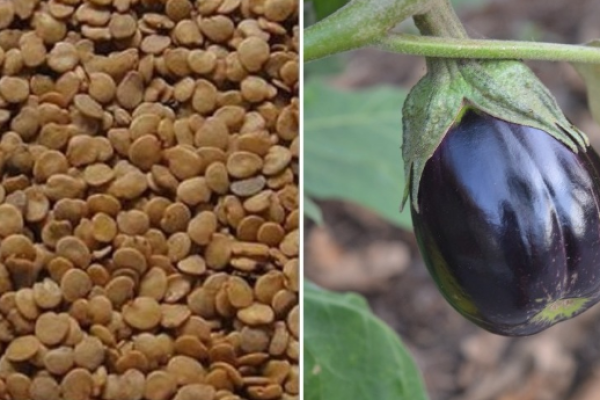Brinjal Seed Germination (Eggplant) Procedure
Brinjal Seed Germination (Eggplant) Procedure

Brinjal is also called or Eggplant is an important solanaceous crop of subtropics and tropics. Eggplant is a plant of the family Solanaceae is also known as the nightshades and from genus Solanum. Brinjal is well regarded among the vegetables increasingly sought by consumers, whose demand for food with potential health-promoting effects, such as disease prevention, is escalating. It is said that Brinjal fruits associate good nutritional value and therapeutic properties. In this article we also discussed below topics;
A step by step guide to Brinjal seed germination
Brinjal is cultivated under a wide range of soils. Since a long duration crop with high yield, well-drained and fertile soil is preferred for the Brinjal crop. Crops grown in sandy soils yield early and grown in clayey soils yield more. The ideal pH for the cultivation of the Brinjal crop is 5.5 – 6.6. Germination of Brinjal seeds is a key factor for crop growth and yield. Low seed germination percentage, slow rate, and lacking in seedling growth are a common problem in most horticultural crops.
- How long does Brinjal seed take to germinate
- Process for germinating Brinjal seeds
- Brinjal seed germination period
- What temperature do Brinjal seeds need to germinate
- Factors affected for Brinjal seed germination
- How do you germinate Brinjal seeds
- How do you germinate Eggplant seeds quickly
- What temperature do Eggplant seeds germinate
- Does Eggplant need light to germinate
- How much space do Eggplants need
Soil and field preparation for Brinjal seed germination
The Brinjal can be grown in all types of soil varying from light sandy to heavy clay soil. Light soils are good for early crop yield, while clay-loam and silt-loam are well suited for higher yield. Loam soil and sandy soil of normal and higher status are best suited for Brinjal cultivation. The soil should fertile and also well-drained. Brinjal is a hardy crop and can be grown even in adverse conditions like in soil having high pH Brinjal has great adaptability. Since the Brinjal crop remains in the field for several months. The soil must be thoroughly prepared by plowing 4 to 5 times before transplanting the seedlings. Bulky organic manures such as well rotten crowding or compost should be incorporated evenly on the soil.
Brinjal seed germination time and temperature
Brinjal seeds germinate in 7 to 14 days, depending on the heat, moisture provided, and moisture content and age of the seed. Brinjal is a warm-season crop and requires relatively high temperatures for optimum growth 25-32°C during the day and 21-27°C at night. The optimum temperature for Brinjal seed germination ranges from 22-30°C.
Stages of Brinjal growth
The following are the stages of Eggplant growth. The more you know about how your Brinjal plant grows the more success you’ll have to grow this versatile plant.
Seeds – After sowing the seeds in warm soil, they take from 1 to 2 weeks to sprout.
Seedlings – Once the seeds germinate, seedlings grow for 6 to 10 weeks before they’re ready to transplant. You can tell that seedlings are strong enough to transplant when they develop from 4 to 6 leaves. Cold temperatures are deadly for seedlings, so it should be at least 18°C before transplanting them to the garden.
Adult Plants – It takes Brinjal 70 to 120 days to reach maturity, depending on the variety. When mature, and they have the main stem and several stems that branch out. The stems grow large, leathery, oval-shaped leaves and some varieties of Eggplant leaves can be spiny or hairy. Eggplants grow from 2 to 4 feet. Some mature Brinjal needs to be staked, so the Brinjal fruit doesn’t pull them down into the soil.
Flowers – Once the Brinjal reaches the mature stage, purple, star-shaped flowers appear.
Fruit – Depending on the Brinjal variety, the fruit can be purple, white, or striped. Most Brinjal produces purple fruit that grows from 7 to 10 inches when mature. Different Brinjal cultivars bear fruit in 50 to 80 days.
Harvest – Once the fruit develops on your Brinjal, pick them while they’re still young for the best flavor. You can tell the Brinjal fruit is ripe when it has glossy skin and a firm texture. If you’re planning on harvesting the seeds for planting in the future, wait until the Brinjal fruit is large with dull skin, and feels soft to the touch.
The sowing time of Brinjal
The time of sowing Brinjal seed and transplanting of seedlings varies according to the agro-climatic regions. There are generally two sowing seasons, June to July for autumn crop and November for the spring-summer crop month of April.
Spacing requirements of Brinjal seeds
Sow Brinjal seeds ½ inch deep and space plants 18-24 inches apart. Spacing mainly depends upon the type of variety grown and the season of planting. Generally, the long fruited varieties are transplanted at 60 x 45 cm, the round varieties at 75 x 60 cm, and high yielding varieties at 90 x 90 cm spacing. Brinjal seedlings are transplanted in furrows in light soils and on side of the ridges in case of heavy soils. Pre-soaking irrigation is given 3 to 4 days before transplanting. At the time of transplanting, the roots of the seedlings must be dipped in a solution of Bavistin (2g/liter of water). Transplanting preferably is done in the evening.
The seed rate and seed treatment of Brinjal
Use seed rate of Brinjal is about 300-400 gm for preparing seedling for one-acre land sowing. For sowing use only trusted and good Brinjal seeds. Before sowing does seed treatment with Thiram by 3gm or Carbendazim by 3gm/kg of seeds. After chemical treatment, treat seeds with Trichoderma viride by 4gm/kg of seed, dry in the shed, and sow immediately. All the seeds of Brinjal were disinfected with ethanol 70% for three minutes and rinsed three times with distilled or sterilized water, before treatments.
Sowing season and sowing method of Brinjal
Process of Brinjal seed germination
Step 1) Once you’ve chosen the Brinjal seed, your first task is getting those seeds started, which can be tricky with Brinjal. Plan to start seeds 8 to 10 weeks before your last frost date. That will allow plants enough time to become sturdy. Bottom heat is essential to reach that goal and hating cables help, but they may not suffice, since most are set for 21°C, and Brinjal prefer it a bit warmer, ideally 23°C.
Step 2) Brinjal seeds should be very lightly covered with soil mix. Bottom watering systems, which use capillary action to give water to the soil mix, help prevent seeds from washing deep into the mix, which sometimes results from overhead watering.
Step 3) Supplemental light isn’t necessary until the Brinjal seeds have germinated, but start it right away. This mimics the ideal growing conditions for Brinjal and helps promote bushy, sturdy growth. 12 to 14 hours of bright light will help prevent the plants from getting leggy. I set my lights 6 inches above the flats.
Step 4) Brinjal seeds germinate in 7 to 14 days, depending on the heat, moisture provided, and moisture content and age of the seed. Seedlings with two sets of plant leaves can be transplanted into 4-inch or 2 x 2 x 6-inch pots two to three weeks after germination. Most potting mixes include fertilizer, but if yours doesn’t, you can’t just forget about it. Feed seedlings with pelleted fertilizer or twice-weekly applications of half-strength fish emulsion. And as the plants grow, move the light source to just 2 inches above the plants. An additional 6 weeks of growth will produce plants that rival those at the garden center.
Tips to start Brinjal seed germination
Good quality soil
By mixing different ratios of vermicompost (worm castings) with normal potting soil and monitoring the best results. It can help prevent damping off (a fungal disease), increase vigor, and potentially even affect seed germination. Even if you don’t use vermicompost, you want to start with a high-quality potting soil for starting seedlings.
Water and cover the seeds
Water and cover the seeds for good even germination Brinjal seeds. Seeds need water and temperature to germinate. During germination, they don’t want to dry out. Cover mine with a damp paper towel to retain moisture, you can cover with plastic lids to trap in moisture and keep them warm.
Keep warm and moist
Eggplant seed staying warm and moist for germination. Use a heating pad to keep temperature-sensitive seeds like Eggplants warm, but sometimes the heat of a grow light can be sufficient or just a stable indoor room temperature levels. The seeds don’t need light until they have germinated, but you’ll want to be ready to provide good light once they do. Ideally, we’ll expose Eggplant seeds to 16 hours a day of full-spectrum light. This is something a sunny window cannot provide in the winter season.
Pests that affect the growth of the Brinjal plant
Aphids, beetles, and spider mites are the main pests that affect the growth of the Brinjal plant. These can be picked by hand and can be avoided with regular inspection for eggs on the Brinjal plants. Bacterial rot is also a common ailment of the plant, which can be prevented by crop rotation and letting the soil receive proper oxygen.
The procedure for Brinjal harvesting
The Brinjal fruits are harvested when they attain full size and color but before the start of ripening. Tenderness bright color and glossy appearance of Brinjal fruit is the optimum stage of harvesting of fruits. When the Brinjal fruits look dull, it is an indication of maturity and loss of quality.
The Brinjal fruits become ready for first picking in about 120-130 days of seed sowing depending on the variety. The harvesting of the Brinjal fruits should be done as soon as it attains a good size and color. Brinjal fruits are harvested when they become greenish-yellow or bronze and their flesh turns dry and tough. Pressing the thumb against the side of the fruit can indicate the maturity of the Brinjal fruit. If the pressed portion springs back to its original shape, the Brinjal fruit is too immature. Some portion of the calyx and the stem-end is retained on the fruit during harvesting and all the fruits do not mature at the same time, the fruits are harvested at an interval of 8-10 days. The Brinjal yield varies from season to season, variety to variety, and location to location. However, in general, 250 to 500 quintals/hectare of healthy fruits of Brinjal can be obtained.
Do Brinjal seeds need sunlight to germinate?
Germination is the process by which seeds sprout and seeds must go through several stages of development before being ready to sprout. Light on the soil is not necessary for Brinjal seed germination because warmth, water, and oxygen are the only conditions necessary for a seed to germinate.
How long does Brinjal take to grow?
Brinjal requires 100 to 120 days to reach maturity from seed, but choosing a faster-maturing variety and establishing optimal growing conditions can bring fresh, ripe Eggplants more quickly from your garden
How do you take care of a Brinjal plant?
Make sure that you are watering your Brinjal plant daily. In climates that are hot and dry, your Brinjal plant will need to be watered several times in a day. Touch the surface of the soil and feel the soil by making use of fingers and water the soil if it is dry.
Why is Eggplant wilting?
Eggplants mainly suffering from over-watering and drought eventually die. Over-watered Eggplant roots rot, which prevents Eggplants from taking up water and causes wilting. Under-watered Brinjal plants also wilt, grow poorly and develop pithy fruits.
Why is Eggplant not producing fruit?
When an Eggplant is stressed, its blossoms will dry up and drop off without producing fruit. The most common reason an Eggplant gets stressed is due to a lack of water.
Why Eggplant leaves curling?
If you notice Eggplant leaves curling, and have blotchy green patches, then one reason could be the cucumber mosaic virus. Then, this virus causes misshapen leaves that have a deformed, curled, shoestring appearance. Then, this disease infects many of the nightshade family plants, causing stunted growth.
Posted
3 years ago
No comments yet! Why don't you be the first?










Add a comment